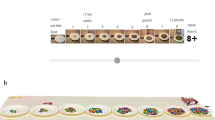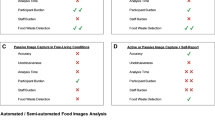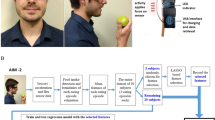Abstract
Objective:
To test the validity of a colour food photography atlas for quantifying portion size eaten compared with weighed foods.
Design:
The colour food photography atlas was prepared by cooking, weighing and taking digital photographs of three portion sizes of 434 foods and beverages typical of the Italian diet.
Subjects and interventions:
In all, 448 male and female volunteers aged 6–60 y from a wide variety of social backgrounds completed 9075 assessments of food portions eaten at lunch and dinner in relation to a set of colour food photographs during 8 weeks of investigation. The amounts of foods eaten by individuals in five different cafeterias in Pavia, Northern Italy, were weighed by trained investigators at the time of serving and, within 5–10 min of the end of the meal, each subject was asked to quantify all foods consumed with reference to one of the three food photographs or in terms of virtual portions among those shown in the photographs.
Results:
Multiple regression analysis shows that weights of portion sizes chosen from the set of photographs are significantly associated (P<0.05) to weights of eaten portions (β=0.81; R2=0.70) and are independent of age, gender and BMI. The differences between mean weights of the portions chosen by individuals from photographs and mean weights of eaten foods are significant for all food categories (P<0.05), except for bread. However, because of the very large number of observations, the mean differences are very small (range: from +23.2 g (+11.2%) for first courses to −1.3 g (−2.7%) for bread). Bland–Altman plots show that first courses limits of agreement are wide because the dispersion is increasing while weights are rising.
Conclusions:
The use of a series of three photographs and virtual portion sizes being associated with relatively small errors, our findings support the validity of using this colour food photography atlas as a tool for quantifying food portion size in epidemiological dietary surveys on different age groups of Italian subjects.
This is a preview of subscription content, access via your institution
Access options
Subscribe to this journal
Receive 12 print issues and online access
$259.00 per year
only $21.58 per issue
Buy this article
- Purchase on Springer Link
- Instant access to full article PDF
Prices may be subject to local taxes which are calculated during checkout








Similar content being viewed by others
References
Bandini LG, Schoeller DA, Cyr HN & Dietz WH (1990): Validity of reported intake in obese and non obese adolescents. Am. J. Clin. Nutr. 52, 421–425.
Bland JM & Altman DJ (1986): Statistical methods for assessing agreement between two methods of clinical measurements. Lancet 8 feb, 307–310.
Byers T, Marshall J, Fiedler R, Zielezny M & Graham S (1985): Assessing nutrient intake with an abbreviated dietary interview. Am. J. Epidemiol. 122, 41–49.
Chu SY, Kolonel LN, Hankin JH & Lee J (1984): A comparison of frequency and quantitative dietary methods for epidemiologic studies of diet and disease. Am. J. Epidemiol. 119, 323–333.
Cole TJ, Bellizzi MC, Flegal KM & Dietz WH (2000): Establishing a standard definition for child overweight and obesity worldwide: international survey. Br. Med. J. 320, 1240–1243.
Edington J, Thorogood M, Geekie M, Ball M & Mann J (1989): Assessment of nutritional intake using dietary records with estimated weights. J. Hum. Nutr. Diet. 2, 407–414.
Faggiano F, Vineis P, Cravanzola D, Pisani P, Xompero G, Riboli E & Kaaks R (1992): Validation of a method for the estimation of food portion size. Epidemiology 3, 379–382.
Guthrie HA (1984): Selection and quantification of typical food portions by young adults. J. Am. Diet. Assoc. 12, 1440–1444.
Hankin JH, Wilkins LR, Kolonel LN & Yoshizawa CN (1991): Validation of quantitative diet history method in Hawaii. Am. J. Epidemiol. 133, 616–628.
Hultén B, Bengtsson C & Isaksson B (1990): Some error inherent in a longitudinal dietary survey revealed by the urine nitrogen test. Eur. J. Clin. Nutr. 44, 169–174.
Lee P & Cunningham K (1990): Irish National Nutrition Survey. Dublin: Irish Nutrition and Dietetics Institute.
Linee Guida per una Sana Alimentazione Italiana (2003): Ministero delle Politiche Agricole e Forestali. Istituto Nazionale di Ricerca per gli Alimenti e la Nutrizione, Revisione 2003.www.inran.it/LG2003.htm.
Morgan S, Flint DM, Prinsley ML, Wahlqvist ML & Parish AE (1982): Measurement of food intake in the elderly by food photography. Proc. Nutr. Soc. Aus. 7, 172.
Navarro A, Cristaldo PE, Diaz MP & Eynard AR (2000): Food photography atlas: its suitability for quantifying food and nutrient consumption in nutritional epidemiological research in Cordoba, Argentina. Rev. Fac. Cien. Med. Univ. Nac. Cordoba 57, 67–74.
Nelson M, Atkinson M & Darbyshire S (1994): Food photography I: the perception of food portion size from photographs. Br. J. Nutr. 72, 649–663.
Nelson M, Atkinson M & Darbyshire S (1996): Food photography II: use of food photographs for estimating portion size and the nutrient of meals. Br. J. Nutr. 76, 31–49.
Pietinen P, Hartman AM, Haapa E, Rasanen L, Haapakoski J, Palmgren J, Albanes D, Virtamo J & Huttunen JK (1988a): Reproducibility and validity of dietary assessment instruments. I. A self-administrated food use questionnaire with a portion size picture booklet. Am. J. Epidemiol. 128, 655–666.
Pietinen P, Hartman AM, Haapa E, Rasanen L, Haapakoski J, Palmgren J, Albanes D, Virtamo J & Huttunen JK (1988b): Reproducibility and validity of dietary assessment instruments.II. A qualitative food frequency questionnaire. Am. J. Epidemiol. 128, 667–676.
Prentice AM, Black AE, Coward WA, Davies HL, Goldberg GR & Murgatroyd PR (1986): High levels of energy expenditure in obese women. Br. Med. J. 292, S983–S987.
Prentice AM, Black AE, Murgatroyd PR, Goldberg GR & Coward WA (1989): Metabolism or appetite: questions of energy balance with particular reference to obesity. J. Hum. Nutr. and Diet. 2, 95–104.
Robson PJ & Livingstone MBE (1999): An evaluation of food photographs as a tool for quantifying food and nutrient intakes. Public Health Nutr. 3, 183–192.
Rutishauser IHE (1982): Food models, photographs or household measures? Proc. Nutr. Soc. Aus. 7, 144–145.
Samet JM, Humble CG & Skipper BE (1984): Alternatives in the collection and analysis of food frequency interview data. Am. J. Epidemiol. 120, 572–581.
Tjonneland A, Overvad K, Haraldsdottir J, Bang S, Ewertz M & Jenson OM (1991): Validation of a semi-quantitative food frequency questionnaire developed in Denmark. Int. J. Epidemiol. 20, 906–912.
Turconi G, Camera E, Bazzano R, Bertoli S, Carolei A, Cena H & Lanzola E (1999): Confronto del diario alimentare autocompilato e del diario di attività fisica con il dispendio energetico stimato in soggetti sovrappeso ed obesi. La Clin. Dietol. 27, 149–153.
Turrini A, Saba A, Perrone D, Cialfa E & D'Amicis A (2001): Food consumption patterns in Italy: the INN-CA Study 1994–1996. Eur. J. Clin. Nutr. 55, 571–588.
Williamson DA, Allen HR, Martin PD, Alfonso AJ, Gerald B & Hunt A (2003): Comparison of digital photography to weighed and visual estimation of portion sizes. J. Am. Diet. Assoc. 103, 1139–1145.
Wolper C, Heshka S & Heymsfield SB (1995): Measuring food intake: An overview. In Handbook of Assessment Measures for Eating Behaviours and Weight-Related Problems ed. Allison D, pp 215–240. Thousand Oaks, CA: Sage Publishing.
Author information
Authors and Affiliations
Corresponding author
Additional information
Guarantors: Turconi G and Guarcello M.
Contributors: TG and GM: project of the study and development of food colour photography atlas; GBF and CA: statistical analysis; BR: dietitians' coordinator in validation study; RC: supervisor.
Rights and permissions
About this article
Cite this article
Turconi, G., Guarcello, M., Berzolari, F. et al. An evaluation of a colour food photography atlas as a tool for quantifying food portion size in epidemiological dietary surveys. Eur J Clin Nutr 59, 923–931 (2005). https://doi.org/10.1038/sj.ejcn.1602162
Received:
Revised:
Accepted:
Published:
Issue Date:
DOI: https://doi.org/10.1038/sj.ejcn.1602162
Keywords
This article is cited by
-
Assessment of Dietary Intake in Three Cohorts of Advanced Age in Two Countries: Methodology Challenges
The Journal of nutrition, health and aging (2023)
-
Development and validation of nutrient estimates based on a food-photographic record in Japan
Nutrition Journal (2020)
-
Dietary habits affect fatty acid composition of visceral adipose tissue in subjects with colorectal cancer or obesity
European Journal of Nutrition (2020)
-
Patient empowerment and the Mediterranean diet as a possible tool to tackle prediabetes associated with overweight or obesity: a pilot study
Hormones (2019)
-
Validation of a self-administered web-based 24-hour dietary recall among pregnant women
BMC Pregnancy and Childbirth (2018)



